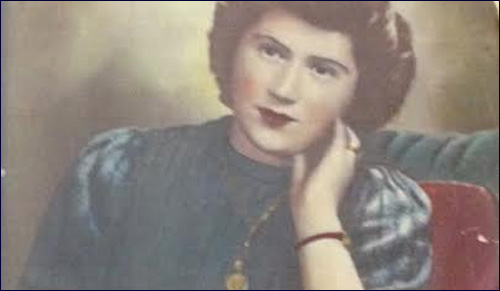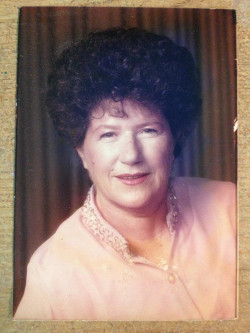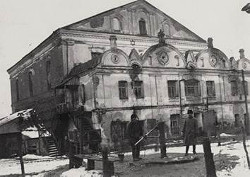 Iran’s Attack on Israel
Iran’s Attack on Israel


7 min read
The thrilling, true story of Rachel Blum’s struggle to survive in a world bent on destroying her.
It was a daunting assignment: speaking to 120 eighth grade girls about the Holocaust in the last hour of the last day of their school year. Compounding my challenge, it was gloriously sunny outside. The girls would be anxious to take leave for their summer vacation.
In my favor, I was going to tell them a remarkable story: that of my mother-in-law, Rachel Blum, may her soul rest in peace – a story I have told to spell-bound audiences and have recently published in book form under the title Run Rachel Run.
 I told these teenage girls that my mother-in-law was roughly their age during the war years, beginning in June 1941 when the Nazis invaded her town, until July 1944 when the Russians liberated Lublin where she had been hiding with a non-Jewish family.
I told these teenage girls that my mother-in-law was roughly their age during the war years, beginning in June 1941 when the Nazis invaded her town, until July 1944 when the Russians liberated Lublin where she had been hiding with a non-Jewish family.
Then I dove into the story, which is truly incredible and gripping – including a Hollywood-worthy climax as Rachel rides in the caboose of a speeding train transporting a thousand SS soldiers to Germany. Fearful an SS officer is about to discover she is Jewish, she convinces the conductor – Ivan Roluk, husband of the non-Jewish couple who took her in – to overturn the train by speeding up around a sharp bend and blowing the horn just beforehand to allow her and his family to jump. (It worked, the family survived and many Nazis were killed; 15-year-old Rachel was responsible for the death of more SS Nazis in one shot than the combined efforts of all the legendary fighters of the Warsaw Ghetto Uprising!)
Despite the dramatic nature of that story, I will save the details for the book and instead share another story, one which is in some ways even more incredible.
 The Main Shul in Ludmir
The Main Shul in Ludmir
Rachel’s childhood town, Ludmir, was home to about 22,000 Jews before the war. On Rosh Hashanah 1942, the Nazis, with the help of local collaborators, began marching columns of bedraggled Jews to a spot outside town and machine-gunned them to death into open pits. Between 15,000 and 18,000 Jews lost their lives that way. And Ludmir was just one of countless Jewish towns in Eastern Europe; all told, some million-and-a-half Jews suffered a similar fate under Nazi domination (even before the gas chambers started operating).
Rachel and her family survived thanks to an ingenious attic hideout. And for the next year, she survived by staying in hiding, smuggling in food for her family and ultimately joining the few thousand survivors in the Ludmir ghetto who had been conscripted into brutal slave labor battalions. Over the year, though, each family member was killed or died of starvation.
This woman risked her life to keep Rachel – until one day when an anti-Semitic neighbor discovered her.
Finally, on December 25, 1943, the Nazis came to finish off everyone left in the ghetto. In miraculous fashion – Rachel found a hiding place beneath a wooden porch. A few days later she emerged and made her way to a Polish woman her family knew before the war.
This woman risked her life to keep Rachel – until one day when an anti-Semitic neighbor discovered her. Frightened for her own life now, the Polish woman told her she had to leave by the early morning.
It was January 1944. A fresh layer of deep snow lay on the ground. The air was biting cold. And a little girl, improperly dressed, was alone and on the run again.
She wandered the streets of non-Jewish Ludmir for a while before entering a barn. Her entire body chilled to the bone, she found a spot at the far end and stuck her feet into a stack of hay to warm them up.
Suddenly, a woman walked in. Their eyes met. Rachel pleaded with her to be quiet, promising she would be gone by the next morning. The woman said nothing, gathered some items and left.
As the day turned into evening, Rachel prepared to leave. The night before she had experienced a powerful dream where her recently-deceased father appeared to her and told her everything would be alright. Drawing courage from the dream, she exited the barn and approached the house next to it.
She knocked on the door. The woman she had seen earlier in the day opened it and invited her inside. The woman then introduced her husband and their seventeen-year-old son (who Rachel later found out worked in the local SS office!). They offered her a bowl of soup. During conversation it emerged that this family, the Roluks, knew Rachel’s father. They praised him for being a very righteous and honest man they had had business dealings with. If they did not have money to pay for the items he gave them on consignment, he did not pressure them to pay.
At this point in the war, both Rachel and the Roluks knew the Nazis would kill any family caught harboring a Jew. Understanding the predicament, Rachel asked Mrs. Roluk if she and her family were religious. She answered affirmatively. Rachel then asked her if they had a Bible. Again affirmative. Rachel next requested that she take the Bible and place it on the table. She did. Finally, Rachel said to the entire family, “I want all of you to place your hands on the Bible.” They complied.
“Now, promise me on this Bible that after the war you will find Jewish people and tell that there is a little Jewish girl buried in the backyard.”
“Now, promise me the following,” the 14-year-old recently orphaned Jewish girl said. “I have nowhere to run. I’m tired and I’m alone. After this, I will go outside to your backyard and lie down in the snow. There I will freeze to death. You will bury me. Now, promise me on this Bible” – and it is difficult to convey the quality of conviction in my mother-in-law’s voice even as she retold it decades later – “that after the war you will find Jewish people and tell that there is a little Jewish girl buried in the backyard. Promise me that you will tell them that her last wish was that she be reburied with other Jews in a Jewish cemetery.”
A deathly silence fell upon the room. The Roluks looked at each other. One by one, they rose from the table and walked into the next room. Rachel could hear them talking. After a while, they returned and said to her, “You will stay with us. We will tell people that you are our niece from another village.”
What the Roluks did not know at the time was that in saving Rachel they were saving themselves – not only in soul but in body too. (This is detailed in the book. Hint: it has to do with the train story above.)
By the end of my lecture, the 120 girls were mesmerized. The most amazing part of Rachel’s story is that – despite the fact that by war’s end she had no family, friends or money – she became the happiest, most active, most loving and helping human being; someone who regularly said with absolute sincerity, “Nothing bad ever happened to me.”
The story of my mother-in-law inspires on many levels. She is a genuine heroine. As Jews, her story impresses upon us an added message: the value of what it means to be Jewish. Perhaps most of all, we learn from her that even if very bad things happen to us, we have within ourselves an astonishing, mysterious, inextinguishable untapped capacity to love; to be truly happy, active, focused and a magnet of joy for others. God knows, the world needs more of that.
Run Rachel Run tells the thrilling, true story of Rachel Blum’s struggle to survive in a world bent on destroying her. Click here to order.
